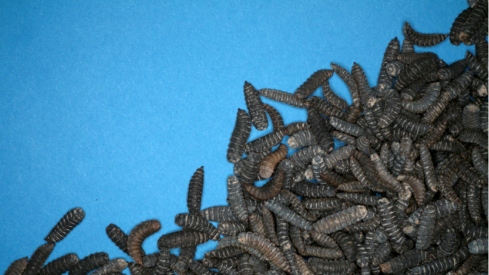Should alternative proteins be part of wet pet food formulations?

The interest in developing alternative and more sustainable protein sources is soaring, also for pet food.
2020 saw a whopping $3.1 billion (€2.73M) invested in the development of alternative protein sources globally, three times more than in any previous year, according to the non-profit organization Good Food Institute.
This record figure underlines the growing concerns around the carbon footprint of conventional protein sources and the need to develop sustainable alternatives.
Insect protein is one alternative that has recently been approved for pet food use and is gaining ground. However, it is mainly used in dry food, with fewer applications in wet formulations. Considerations around pet food texture give us an insight into why.
Dry kibble is low moisture (10 – 12%) normally with a homogeneous texture typically determined by starch from starchy ingredients and created in the extrusion process. By comparison, wet pet food is high moisture (70 – 80%) and has an heterogenous product matrix that requires ‘functional’ ingredients to help create and stabilise the texture.
Depending on the product type, wet pet food texture is controlled by a combination of meat functionality and added water and fat binders and texturizing agents like gels.
In wet pet food, an important factor is meat protein heat setting functionality to create textures that survive the heat sterilisation process. However, meats used in pet food show wide variability in heat setting ability from ‘high’, for example, liver, to ‘low’ for chicken heads and feet.
Controlling this and overcoming inherent variability, are reasons for inclusion of highly functional ingredients like spray dried animal plasma, plant proteins, fibre concentrates and gelling agents.
This approach might also be required when formulating alternative proteins. For example, sustainable fibre concentrates or plant proteins might be added alongside mycoprotein. However, when formulating alternative proteins for eco-friendly benefits and meeting critical success factors, 100% protein replacement with an alternative protein might not be realistic.
Partial replacement might be more feasible – sustainable pea protein, for example, can potentially partially replace animal-derived spray blood plasma.
Challenges for the industry
Due to R&D constraints, alternative protein implementation might require us to consider new ways of working to overcome challenges and achieve the benefits.
This collaborative working might include pet food producers working more closely with alternative protein suppliers and engaging a specialist technical consultant with expertise in wet pet food ingredients, recipes, functionality, and texture.
Reducing your pawprint in wet pet food offers potential benefits but presents both new and conventional challenges.
Success is more likely if you embrace new ways of working and a multifactorial approach to overcoming the challenges and delivering the benefits.
